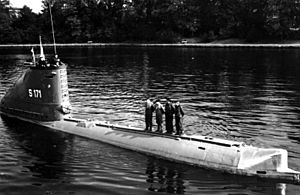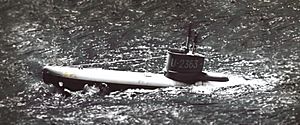German submarine U-2363 facts for kids
The German submarine U-2363 was a special type of small submarine called a Type XXIII U-boat. It was part of Nazi Germany's navy, the Kriegsmarine, during World War II. This submarine was ordered in September 1944 and built in Hamburg, Germany. It was ready for action in February 1945, commanded by a naval officer named Karl Frahm.

Postwar photo of Hecht (S 171), (former Type XXIII submarine U-2367). An identical sister ship of U-2363.
|
|
Quick facts for kids History |
|
|---|---|
| Name | U-2363 |
| Ordered | 20 September 1944 |
| Builder | Deutsche Werft, Hamburg |
| Yard number | 517 |
| Laid down | 22 November 1944 |
| Launched | 18 January 1945 |
| Commissioned | 5 February 1945 |
| Fate |
|
| General characteristics | |
| Class and type | Type XXIII submarine |
| Displacement |
|
| Length |
|
| Beam |
|
| Draught | 3.66 m (12 ft) |
| Installed power |
|
| Propulsion |
|
| Speed |
|
| Range |
|
| Test depth | 180 m (590 ft) |
| Complement | 14–18 |
| Armament |
|
| Service record | |
| Part of: |
|
| Commanders: |
|
| Operations: | None |
| Victories: | None |
Contents
What Was the U-2363 Like?
The U-2363 was a Type XXIII U-boat, known for being smaller than other submarines. When it was on the surface, it weighed about 234 tons. When it was underwater, it weighed a bit more, around 258 tons.
This submarine was about 34.68 meters (113 feet 9 inches) long. It was 3.02 meters (9 feet 11 inches) wide. The submarine could go as deep as 3.66 meters (12 feet) into the water.
How the U-boat Moved
The U-2363 had different engines to help it move. It used a diesel engine for power on the surface. It also had two types of electric motors for when it was underwater. One electric motor was for regular speed, and another was a special "silent running" motor. This silent motor made it very quiet, so enemies would have a harder time finding it.
When on the surface, the submarine could travel at a top speed of 9.7 knots (about 18 kilometers per hour or 11 miles per hour). Underwater, it could go faster, reaching 12.5 knots (about 23 kilometers per hour or 14 miles per hour).
Range and Crew
The U-2363 could travel a long way without needing to refuel. On the surface, it could go about 2,600 nautical miles (4,800 kilometers or 3,000 miles) at a speed of 8 knots. Underwater, it could travel about 194 nautical miles (359 kilometers or 223 miles) at a slower speed of 4 knots.
The submarine was designed to carry a small crew, usually between 14 and 18 sailors. It was armed with two torpedo tubes at the front. It could carry two torpedoes, which are underwater weapons. Unlike some larger submarines, the U-2363 did not have a deck gun.
The U-2363's Service History
The U-2363 did not see much action during World War II. It was commissioned in February 1945, very close to the end of the war.
On May 9, 1945, the U-2363 surrendered to the Allied forces in Kristiansand, Norway. This was just after Germany surrendered and the war in Europe ended. Later, on May 29, 1945, it was moved to Loch Ryan in Scotland.
Operation Deadlight
After the war, many German U-boats that had surrendered were sunk by the Allied forces. This operation was called Operation Deadlight. The U-2363 was one of 116 submarines chosen to be sunk.
On November 28, 1945, the U-2363 was towed out to sea. It was then sunk by gunfire from two destroyers: the British ship HMS Onslow and the Polish ship ORP Piorun.
Today, the wreck of the U-2363 lies at these coordinates: 56°10′N 10°05′W / 56.167°N 10.083°W.
See also


